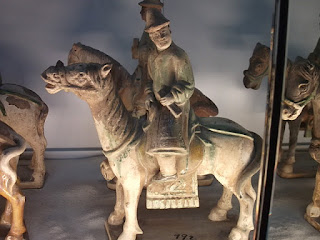BY: ROWENA MCGOWAN
There are some artifacts that are universally acknowledged as pretty darn cool. No one is going to give you a strange look if you say you love Tutankhamun’s mask, the Venus de Milo or the Antikythera Mechanism. But then there are the other objects in museums – the small ones, the obscure ones, the ones that most people breeze right past. This is one such object:
 |
| Tomb figure at the Royal Ontario Museum. Photo by Rowena McGowan |
It’s a Ming tomb figure located in the Chinese Architecture Gallery at the Royal Ontario Museum and, even if you’ve been to the ROM a hundred times, you may have missed it. It’s not set apart in any way. It’s in a case with a bunch of other, incredibly similar figures. It’s not even a particularly centrally placed case.
Culturally, there’s nothing particularly special about this particular figure either. It’s a tomb figure, which have been used in China since the Western Zhou Dynasty (1046–771 BC). Tomb figures are fairly interesting as a broad cultural phenomenon. They were figures of people, animals or household implements placed in the tomb. They were also, in many ways, a compassionate item – before the introduction of tomb figures, those servants in the afterlife would be living humans and animals, buried alive to serve their master in death as they had in life.
Tomb figures arguably reached their zenith during the Tang Dynasty. They were produced en masse and there were actually rules governing how many figures a person of each rank could place in their tomb. These rules tended to be ignored, of course, because people are people. Aesthetically, Tang figures were beautifully made, with a great deal of life and movement.
 |
| Tang tomb figure in the British Museum. Source. |
By the Ming Dynasty, the creation of tomb figures was not so skilled. A quick history lesson: the Ming Dynasty was the first dynasty after Mongol rule was overthrown in China.
 |
| Yep, these guys. Source. |
The creation of tomb figures hadn’t stopped during Mongol Rule but it had declined. The Mongols had different burial traditions, less rooted in ancestor worship and feng shui. However, after so many years under the rule of invaders, it was important to the Ming government to return to more traditional Chinese culture. Cultural cues were deliberately taken from both the Song and Tang Dynasties, which means that tomb figures were very much back in fashion.
Unfortunately, the figures produced during the Ming Dynasty were not nearly as aesthetically beautiful as those from the Tang Dynasty. Figures were much stiffer and had far less personality. You can see that stiffness in my figure; the movement of the horse is quite unnatural.
So, having established that there is absolutely nothing remarkable about this particular figure, either historically or aesthetically, why on Earth is it the Object of the Week?
Put simply, because I like it and even I’m not really sure why. Is it because it’s ever so slightly different from the other figures? Is it that little face turned up towards mine or the horse tossing its head, be it ever so stiffly?
It’s easy to see why a person would fall in love with a big, romantic artifact like the Parthenon Marbles. But I don’t think I’m alone in also occasionally falling in love with something completely and totally unremarkable. And why not? We’re museum people. We are all about the objects. Let’s celebrate not only the big but the small, not only the well-known but the obscure. Let’s love unremarkable objects without having to justify ourselves. Let’s love objects just because we do.
 |
| Shine on, you crazy diamond. |
Works Consulted:
Vainker, S. J. (1991). Chinese pottery and porcelain: From prehistory to the present. New York: George Braziller.
Jacobsen, R. D. (2013). Celestial horses & long sleeve dancers: The David W. Dewey collection of ancient Chinese tomb sculpture.


No comments:
Post a Comment
Note: only a member of this blog may post a comment.